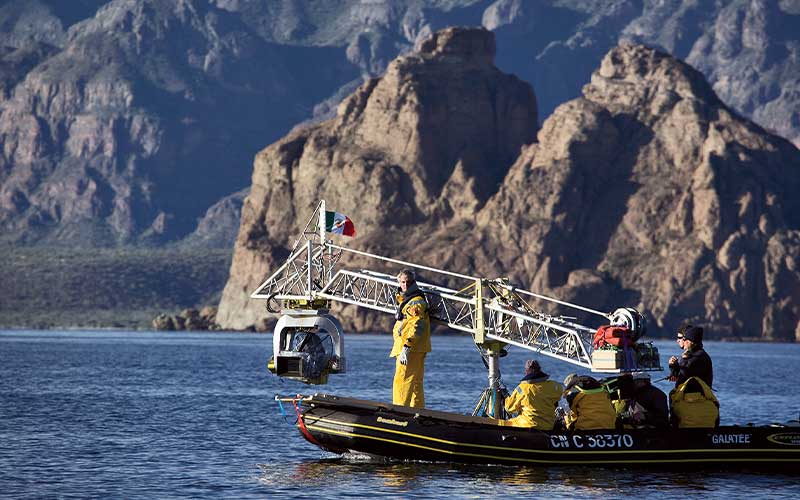In 2006, I had the great fortune to be a still photographer with a French team filming the movie Oceans. Jacques Perrin and Jacques Cluzaud, who were previously recognized for Winged Migrations and Microcosmos, were producing Oceans. Oceans was originally distributed in Europe by Galatée Films, but became known in the United States through its distribution by Disneynature and nationwide debut on Earth Day, April 22, 2010.
Oceans is the most ambitious and largest-budget nature feature film ever attempted. The project was a unique opportunity for me because it has been historically rare for any major nature film to hire a full-time still photographer. But the images generated by still shooters working on the Oceans project resulted in a wide range of publicity uses, perhaps most significantly in the form of coffee-table books that feature only images shot on the job, as well as images never seen before.

There were frequently three film crews working simultaneously across the globe during the four-year project. I was assigned to the team of cameraman/director of photography David Reichert and rebreather guru Mark Thurlow; it was definitely the most challenging assignment of my career. My job description was to “get the best possible image of the cameraman shooting the subject,” as well as the “best possible image of the subject being filmed.” I am not sure young, mid-30s Reichert loved the idea of a “baby boomer” still photographer shadowing him, especially since there is only one thing a motion cameraman hates more than camera-related technical problems, and that’s a still photographer who gets in the way. There’s a good reason for it: If the photographer swims into the frame of just a single “one-time” opportunity, thousands of dollars are wasted as months of preparation and effort are ruined. For still photographers on a motion picture crew, there is no room for error; screw up once, and it’s time to replace the still guy!

I was thrown into the deep end from the very beginning; my first subject assignment was shooting blue whales off the San Diego coast. Blue whales do not offer the same filming opportunities we often see with humpback and sperm whales, which cooperate by hovering relatively motionless in the water column, seemingly oblivious to the cameraman. Blue whales generally dislike boats and avoid photographers in the water. The animal remains at the pinnacle of the difficulty scale. We spent 45 days in Loreto in Baja California and 90 days off the San Diego coast targeting blue whales. My biggest challenge: How do I position myself for a decent shot of this magnificent, elusive animal without getting in Reichert’s frame? My best opportunity came when Reichert swam in one direction while I swam in the other. In that lucky moment, a blue whale swam up to me for a “pass-by” much like a relaxed dolphin would.
For images of the Atlantic bluefin tuna, we traveled to the Mediterranean, off the coast of Turkey. A huge transfer net was towed behind, and the boat was slowed to just a .5 knot so we could work with massive tuna, some of which reached 900 pounds. The spectacular Chrysaora jellyfish images came from Carmel Bay, Calif., during rare conditions of very clear water and a high concentration of animals. We all endured multiple facial stings by the jellies, but it didn’t matter; we got the shot. Other locations included the Azores for sperm whales, as well as California’s Channel Islands and Mexico’s Revillagigedo Islands for the resident mantas. By the time we finished shooting, we were a well-oiled machine that got along great. Of course, it helped that I remained outside of Reichert’s frame!

The Diving
Our team worked from small boats for blue whales, bait balls and other ocean subjects. The preferred diving system was a simple pony bottle, making for easy water entries and exits. While filming sperm and blue whales, some days required up to 20 jumps in the water. Reichert and Thurlow did use a small, compact, 1 atmosphere Biomarine oxygen rebreather for more stationary subjects and the sea otters in Monterey. I preferred an open-circuit pony bottle and freediving. For deep work, Thurlow used his custom Biomarine 15.5 rebreather, Reichert used his Inspiration rebreather, and I used nitrox and open circuit.
Our team all carried DAN membership and insurance, recognizing that remote locations and potential hazards made it smart to be properly prepared. Happily, other than a couple of minor ear events, none of us ever had a significant injury during four years of filming and diving.
Oceans is now available on DVD/Blu-ray in the United States.

© Alert Diver — Q4 Fall 2010